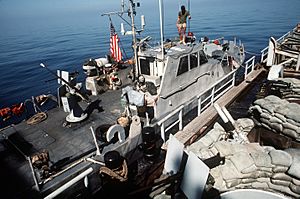Operation Prime Chance facts for kids
Quick facts for kids Operation Prime Chance |
|||||||
|---|---|---|---|---|---|---|---|
| Part of Iran–Iraq War | |||||||
 A U.S. Navy crewman stands atop the cabin of a PB Mark III patrol boat tied up to the oil rig service barge Wimbrown VII in the northern Persian Gulf. The barge is armed with a .50-caliber M2 machine gun, an 81 mm Mark 2 mortar, and a 40 mm Mk 19 grenade launcher. |
|||||||
|
|||||||
| Belligerents | |||||||
| Casualties and losses | |||||||
| None | 5 killed, 26 captured (during raid on Iran Ajr only) Other parts of the operation are not included in this number |
||||||
Operation Prime Chance was a secret military operation by the United States from August 1987 to June 1989. Its main goal was to protect American-flagged oil tankers from attacks by Iran during the Iran–Iraq War. This operation happened at the same time as Operation Earnest Will, which was a larger effort by the U.S. Navy to guide these tankers safely through the Persian Gulf. Operation Prime Chance began after an American-flagged Kuwaiti oil tanker, the Bridgeton, hit a mine.
Contents
Protecting Ships in the Persian Gulf
Operation Prime Chance and Operation Earnest Will worked together. While Earnest Will was a well-known effort to escort ships, Prime Chance was kept mostly secret.
Night Missions and New Technology
During Prime Chance, United States Army helicopters flew missions at night. They took off from Navy ships like frigates and destroyers. They also used two rented barges in the northern Persian Gulf as bases.
These helicopter pilots flew very low, sometimes only about 30 feet (9 meters) above the water. They were among the first to use special equipment in combat, like night vision goggles and forward looking infrared (FLIR) devices. These tools helped them see in the dark.
Special Forces in Action
Navy SEALs and explosive ordnance disposal (EOD) teams also worked from the barges. They helped find and deal with dangers like mines.
The helicopters used different tactics. Smaller, faster MH-6 Little Bird helicopters would act as spotters for the more heavily armed AH-6s. Warships and their SH-60 Seahawk helicopters used their radar to help spot threats too.
How the Operation Started
Planning for Operation Prime Chance began right after the Bridgeton tanker hit a mine. This incident showed that more forces were needed to keep the civilian ships safe.
Getting Ready for Action
The Joint Chiefs of Staff (top military leaders) looked for helicopter pilots who could fly at night from Navy ships. They then trained these pilots for the special challenges of the mission.
Helicopters from the Army's 160th Special Operations Aviation Regiment (Airborne), known as the "Night Stalkers," arrived in the Persian Gulf on August 5, 1987. They joined the Navy's command ship La Salle.
First Missions
The helicopter team was split into two groups. Each group had one MH-6 Little Bird, two AH-6s, and their crews. On August 8, one group helped escort a convoy of ships from the La Salle. The next day, this group moved to the frigate Jarrett to escort another convoy. The other group flew to the frigate Klakring to protect minesweepers working near Farsi Island.
Key Units Involved
Many different military units and ships took part in Operation Prime Chance.
Ships and Bases
- Mobile Sea Bases Hercules and Wimbrown 7: These were barges rented from an oil company. They served as floating bases for SEALs, EOD teams, Navy small-boat crews, and Army helicopters.
- Various U.S. Navy frigates, destroyers, and other ships, including:
- USS Jarrett (FFG-33)
- USS John A. Moore (FFG-19)
- USS Klakring (FFG-42)
- USS Samuel B. Roberts (FFG-58)
- USS Thach (FFG-43)
- USS La Salle (AGF-3)
- USS Reuben James (FFG-57)
- USS Guadalcanal (LPH-7)
Specialized Military Units
- 160th Special Operations Aviation Regiment (Airborne): These "Night Stalkers" were the Army's special aviation unit.
- Task Force 118: This Army aviation unit flew AH-58D Warrior helicopters. Their special sights helped them spot small boats.
- SEAL Team 1 and SEAL Team 2: These elite Navy special forces teams were involved.
- EOD Mobile Unit Five and EOD Mobile Unit Six: These teams specialized in handling and disposing of explosives.
- Special Boat Units (like 11, 12, 13, 20, 24): These units operated small, fast boats for patrols and special missions.
- Other Army and Marine Corps detachments provided ground defense and intelligence support.

